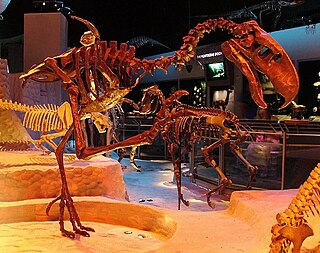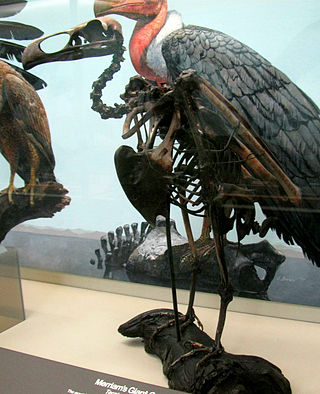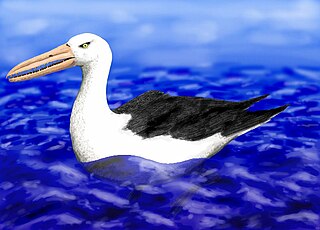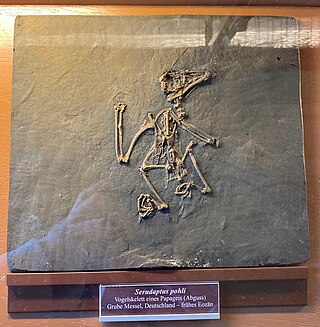
A passerine is any bird of the order Passeriformes, which includes more than half of all bird species. Sometimes known as perching birds, passerines generally have an anisodactyl arrangement of their toes, which facilitates perching.

Gastornis is an extinct genus of large flightless birds that lived during the mid-Paleocene to mid-Eocene epochs of the Paleogene period. Fossils have been found in Europe, Asia and North America, with the remains from North America originally assigned to the genus Diatryma.

Phorusrhacids, colloquially known as terror birds, are an extinct family of large carnivorous flightless birds that were among the largest apex predators in South America during the Cenozoic era; their conventionally accepted temporal range covers from 53 to 0.1 million years (Ma) ago.

Dromornis is a genus of large to enormous prehistoric birds native to Australia during the Oligocene to Pliocene epochs. The species were flightless, possessing greatly reduced wing structures but with large legs, similar to the modern ostrich or emu. They were likely to have been predominantly, if not exclusively, herbivorous browsers. The male of the largest species, Dromornis stirtoni, is a contender for the tallest and heaviest bird, and possibly exhibited aggressive territorial behaviour. They belong to the family Dromornithidae, extinct flightless birds known as mihirungs.

Teratornithidae is an extinct family of very large birds of prey that lived in North and South America from the Late Oligocene to Late Pleistocene. They include some of the largest known flying birds.

Titanis is a genus of phorusrhacid, an extinct family of large, predatory birds, in the order Cariamiformes that inhabited the United States during the Pliocene and earliest Pleistocene. The first fossils were unearthed by amateur archaeologists Benjamin Waller and Robert Allen from the Santa Fe River in Florida and were named Titanis walleri by ornithologist Pierce Brodkorb in 1963, the species name honoring Waller. The holotype material is fragmentary, consisting of only an incomplete right tarsometatarsus and phalanx, but comes from one of the largest phorusrhacid individuals known. In the years following the description, many more isolated elements have been unearthed from sites from other areas of Florida, Texas, and California. It was classified in the subfamily Phorusrhacinae, which includes some of the last and largest phorusrhacids like Devincenzia and Kelenken.

Osteodontornis is an extinct seabird genus. It contains a single named species, Osteodontornis orri, which was described quite exactly one century after the first species of the Pelagornithidae was. O. orri was named after the naturalist Ellison Orr (1857-1951).

The Pelagornithidae, commonly called pelagornithids, pseudodontorns, bony-toothed birds, false-toothed birds or pseudotooth birds, are a prehistoric family of large seabirds. Their fossil remains have been found all over the world in rocks dating between the Early Paleocene and the Pliocene-Pleistocene boundary.

Hongshanornis is a genus of ornithuromorph birds known from early Cretaceous lake deposits of the Yixian Formation, Inner Mongolia, China. The holotype specimen, recovered in 2005, is currently held by the Institute of Vertebrate Paleontology and Paleoanthropology in Beijing. It was found in the Jianshangou fossil beds, dated to 124.6 million years ago. Three additional specimens have been reported, though only one of those has been definitively identified as belonging to Hongshanornis. This latter specimen was found in the Dawangzhangzi fossil beds, which are about 122 million years old.
Hoazinoides is an extinct genus of birds from the Middle Miocene (Laventan) from the "Monkey Beds" of the Villavieja Formation of the Honda Group at the Konzentrat-Lagerstätte of La Venta, Colombia.

Masillaraptor is an extinct genus of masillaraptorid, a group of primitive falconiforms, from the Middle Eocene Messel Pit, Germany. It is a long-legged relative of the living falcons.

Kelenken is a genus of phorusrhacid, an extinct group of large, predatory birds, which lived in what is now Argentina in the middle Miocene about 15 million years ago. The only known specimen was discovered by high school student Guillermo Aguirre-Zabala in Comallo, in the region of Patagonia, and was made the holotype of the new genus and species Kelenken guillermoi in 2007. The genus name references a spirit in Tehuelche mythology, and the specific name honors the discoverer. The holotype consists of one of the most complete skulls known of a large phorusrhacid, as well as a tarsometatarsus lower leg bone and a phalanx toe bone. The discovery of Kelenken clarified the anatomy of large phorusrhacids, as these were previously much less well known. The closest living relatives of the phorusrhacids are the seriemas. Kelenken was found to belong in the subfamily Phorusrhacinae, along with for example Devincenzia.

Devincenzia is an extinct genus of giant flightless predatory birds in the family Phorusrhacidae or "terror birds" that lived during the Early Miocene (Deseadan) Fray Bentos Formation of Uruguay and Late Miocene (Huayquerian) Ituzaingó Formation to Early Pliocene (Montehermosan) of Argentina. The type species D. pozzi was formerly known as Onactornis pozzi. It stood about 2.5 metres (8.2 ft) tall, making it one of the largest Phorusrhacids and carnivorous birds known.
Palaeochenoides is a genus of the prehistoric pseudotooth birds of somewhat doubtful validity. These were probably rather close relatives of either pelicans and storks, or of waterfowl, and are here placed in the order Odontopterygiformes to account for this uncertainty.
Eurofluvioviridavis is a genus of extinct primitive birds from the Middle Eocene Messel Pit, Germany. It contains a single species, Eurofluvioviridavis robustipes. It is related to Avolatavis and Vastanavis, other members of the family Vastanavidae.

Bohaiornithidae is a group of early predatory enantiornitheans from the early Cretaceous Period of China. All known specimens come from the Jiufotang Formation and Yixian Formation, dating to the early Aptian age, 125–120 million years ago. Bohaiornithidae was first coined as a family of enantiornithean birds by Wang and colleagues in 2014. They defined it as the natural group formed by all descendants of the common ancestor of the type species, Bohaiornis guoi, and Shenqiornis mengi.

Bathornis is an extinct lineage of birds related to modern day seriemas, that lived in North America about 37–20 million years ago. Like the closely related and also extinct phorusrhacids, it was a flightless predator, occupying predatory niches in environments classically considered to be dominated by mammals. It was a highly diverse and successful genus, spanning a large number of species that occurred from the Priabonian Eocene to the Burdigalian Miocene epochs.

Halcyornithidae is an extinct family of telluravian birds thought to be related to the Psittaciformes (parrots), Passeriformes (songbirds), and to the extinct Messelasturidae. Halcyornithids have been found in various Eocene formations in Europe and North America. Widespread and diverse in the Early Eocene of North America and Europe, halcyornithids are not found in locales later than the Middle Eocene. Halcyornithids were small, arboreal birds with zygodactyl feet, with two toes facing forwards and two facing back, a trait shared with other tree-dwelling families of Eocene birds like the Zygodactylidae and the messelasturids. The skull of halcyornithids features a ridge of bone above the eye called the supraorbital process, similar to birds of prey. The relationships of the halcyornithids to other birds remain uncertain. Halcyornithids have been proposed as relatives to owls and as a lineage closer to parrots than to songbirds. Most recently, halcyornithids have been identified as the sister group of the clade including parrots and songbirds. It is also possible that Halcyornithidae is paraphyletic with respect to the Messelasturidae.
Oligocolius is an unusual genus of extinct mousebird from the early to late Oligocene epoch of Germany. Oligocolius is known from two species, the type species O. brevitarsus and O. psittacocephalon. Oligocolius is a member of the family of modern mousebirds (Coliidae) and is broadly similar to them in shape. However, unlike modern mouse birds the skull and beak of Oligocolius closely resembles those of parrots, and appears to be specialised for a distinct lifestyle not found in living mousebirds.

Serudaptus is an extinct genus of halcyornithid bird from the Middle Eocene Messel pit in Hesse, Germany. The genus contains one species, Serudaptus pohli, and is known for long, raptorial claws on its zygodactyl feet.













